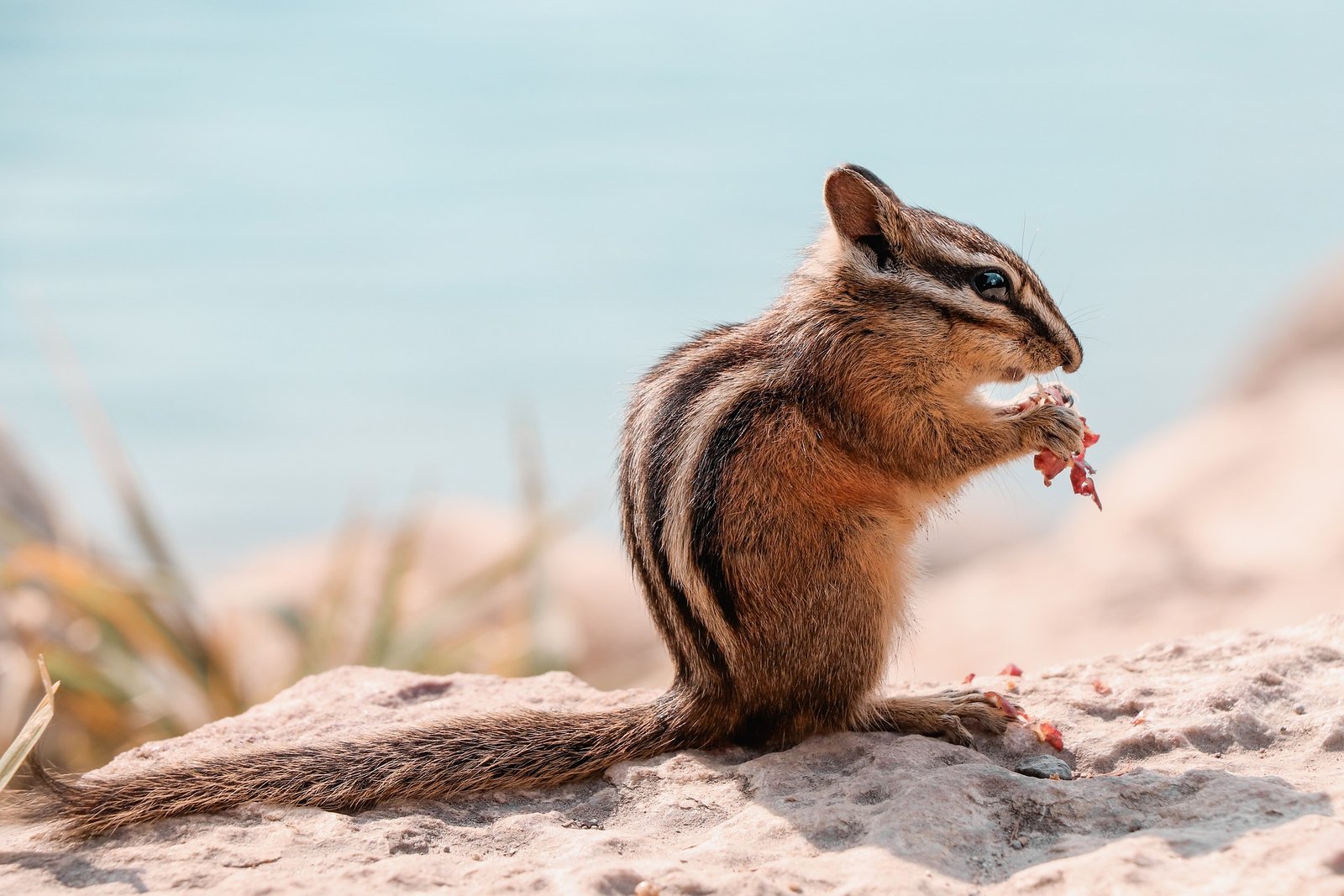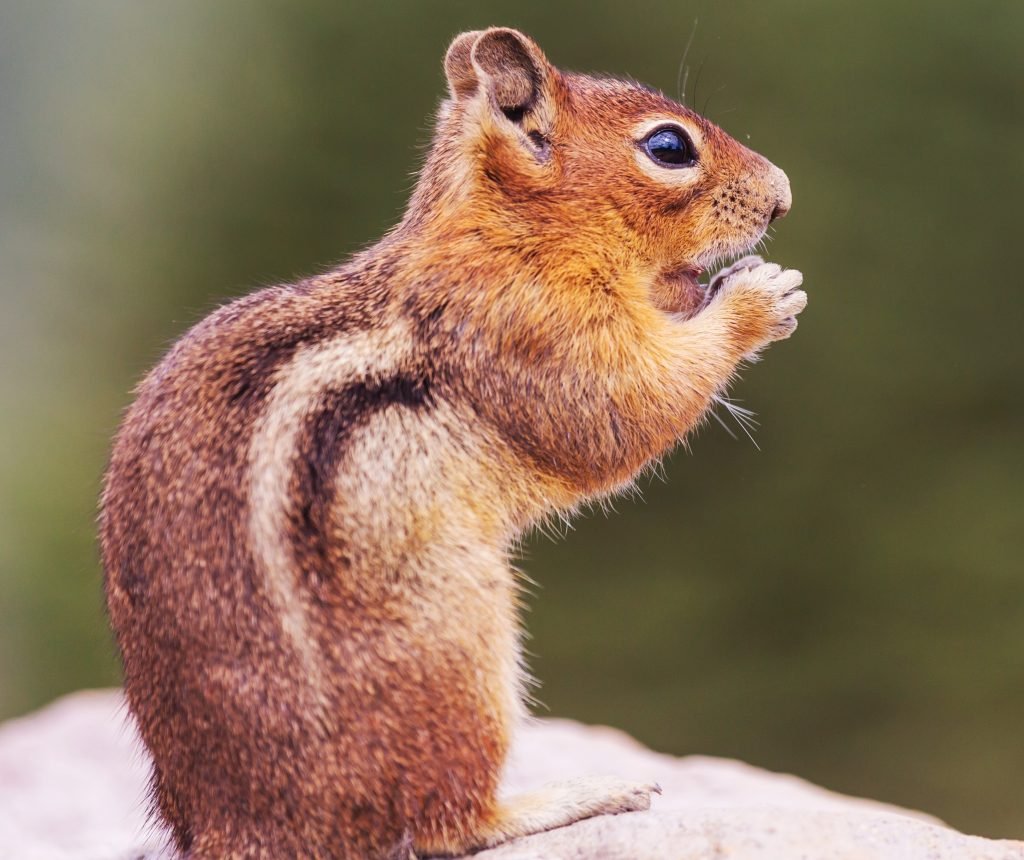Chipmunk: Tamias

Chipmunks and ground squirrels are closely related, with fifteen different species found in North America. Eastern chipmunks and least chipmunks are the two most common species with the widest distribution in North America.
Woodpiles, stumps, brush piles, basements, and garages are places where their burrows can be found. Their burrows are usually around 20-30 feet long and contain food storage and nesting areas. They have side pockets and escape tunnels that are connected to their main shafts.
Learn More: Common Household Pests
Physical Description Of Chipmunks
Chipmunks are small rodents with a distinctive yellowish to reddish patch on their rumps and grayish to reddish-brown fur. The color and pattern of their pelage vary depending on where they live. The undersides of their bodies are white. Five dark stripes run down their sides and back, with the longest stripe running along their midline. A narrow white band runs between their dark lateral stripes. Their face has a light and dark stripes around their eyes. Their tail is hairy but not bushy, and it has a flattened appearance.
Their rounded ears are less than 20 mm in diameter. They have four toes on their forefeet and five on their hindfeet. On either side of their mouth, chipmunks have large cheek pouches. Except for the smallest chipmunks, they are distinguished from all other rodents by a stripe running down their back.
Average Chipmunk Size
The tiniest members of the squirrel family are chipmunks. The Eastern chipmunk is the largest of the chipmunk species. It can reach a length of 11 inches (28 centimeters) and a weight of 4.4 ounces (125 grams).
Chipmunks range in size from 4 to 7 inches (10 to 18 cm) in length and weigh anywhere from 1 to 5 ounces (28 to 142 g). Their tails can grow to be 3 to 5 inches long (8 to 13 cm).
Behavior Of Chipmunks

Chipmunks spend the majority of their time in their burrow during the winter. This dormant period lasts from mid-November to early-March or late-April, depending on local snow depth and temperatures. This species does not hibernate and stores very little body fat before winter. Individuals arousing from short, recurring periods of torpor can find energy in underground food caches.
Some chipmunks may leave their burrows during mid-winter thaws, even digging through several feet of snow, to forage for seeds in nearby areas where the snow has melted, exposing the forest floor.
Chipmunks that live in low-elevation areas or near bird feeding stations in yards may come above ground to eat sunflower seeds in the winter. Chipmunks are diurnal, meaning they only leave their burrows during the day. They are least active in hot, windy, or rainy weather, and in some years, they may only venture out of their burrows in July and August, owing to a lack of food and botfly parasitism rather than hot weather.
Chipmunk Reproduction Cycle
Chipmunks reproduce twice a year, once in the early spring and again in the summer. One litter of 2 to 8 baby chipmunks are born in a den underground after a 31-day gestation period.
The young are born naked, blind, and helpless, but they quickly grow and develop. Their stripes begin to appear on the eighth day of life. Their eyes open after a month, and they are completely covered in fur. The young are weaned and leave the burrow for the first time at six weeks of age.
At the age of eight weeks, full-grown chipmunks leave their parents’ den. By the age of one year, both male and female chipmunks have reached sexual maturity. In the wild, chipmunks can live up to two years, and in captivity, they have been known to live up to eight years.
Habitat Of Chipmunks
These rodents prefer deciduous forest or brushland with rocky ground and plenty of logs and tree stumps as their preferred habitat. Furthermore, Eastern chipmunks are known to coexist with humans, and they frequently inhabit gardens, suburban areas, and outbuildings.
Chipmunk Range & Distribution
Except for the Siberian chipmunk species, the various species are primarily found in North America. The Siberian species can be found across much of northern Asia.
The rest of the species can be found in Canada, the United States, and Mexico. Some species have also been introduced outside of their natural range by humans.
Diet Of Chipmunks

Chipmunks eat a wide variety of nuts, fruits, seeds, berries, grains, birds’ eggs, small frogs, fungi, insects, and worms as part of their omnivorous diet. Food is stuffed into their large cheek pouches, which they carry back to their dens to store. At the beginning of autumn, they gather a large amount of food and store it in their burrows for the winter.
Some chipmunk species have a lot of food caches. The terms “larder hoarding” and “scatter hoarding” are used to describe these two behaviors. Typically, larder hoarders stay in their nests until spring. Chipmunks forage for food on the ground in areas with underbrush, rocks, and logs, where they can avoid predators such as hawks, foxes, coyotes, weasels, and snakes. They will climb trees searching for acorns and hazelnuts, but they are not as agile as their squirrel cousins.
Chipmunks play several important roles in forest ecosystems. Their activities, such as tree seed harvesting and storage, are critical for seedling establishment. Chipmunks are important prey for various predatory mammals and birds, but they are also opportunistic predators, especially when it comes to bird eggs and nestlings.
Chipmunks in urban areas have been observed accepting food from humans; however, human food is not stored and is only consumed as a novelty.
Chipmunk Damage Around The Home
Chipmunks wreak havoc on a property by burrowing beneath sidewalks, patios, and foundations. Chipmunks may dig burrows near the patio, stairs, retention walls, or even the foundation of rural and suburban homes. This can weaken or damage the supports in these areas, causing them to collapse. Chipmunk damage is exacerbated by ice expansion and contraction. Chipmunks eat plants and bulbs, causing damage to valuable landscaping.
Chipmunks are known for gnawing on and devouring fruits, plants, and vegetables and digging up flower bulbs, which makes them a nuisance to gardeners. Birdseed or pet food bags should be kept indoors because they could be a tasty snack. If there are bushes or trees close to your house, you may be unwittingly providing them with cover and easy access.
Signs Of A Chipmunk Infestation
The earlier a chipmunk infestation is discovered, the quicker it can be removed and prevent further damage. Common signs of chipmunks around the home include:
- Seed and grain pilings or caches in secluded locations.
- Small holes in lawns and trails, typically near the home’s foundation, in the middle of a path or walkway, and along the edging (this can damage paving and foundations).
- Holes eaten out of low-hanging vegetables, especially tomatoes, during hot and dry spells are a sign that a chipmunk has been stealing water from your garden.
- Sunflower and corn sprout clumps in the yard, garden beds, and flower pots.
- Bulbs that have been yanked out of the ground.
How To Protect Your Home From Chipmunks?

If you live near a wooded area, your chances of eradicating chipmunks are slim. Your best bet is to defend your yard from the small creatures that lurk on the outskirts in forested areas. Maintain the condition of your property, and any debris piles should be cleaned up. Chipmunks enjoy burrowing, and they will be even happier if they can do so undercover. Once your property is clear of unnecessary clutter, take the time to seal any cracks or holes in the foundations that could attract a chipmunk intruder.
These animals are also attracted to gardens. Chipmunks will raid a garden before a bird feeder, but they will not turn down the chance to steal from the birds. Secure or remove any bird feeders.
Chipmunk Trapping, Removal & Prevention
Chipmunk exclusion is frequently required in homes to prevent these animals from returning after they have been removed. Pest control experts can identify the best approach for each case and install the proper barriers to prevent future issues, whether residents need to protect a garden or seal up a basement.
Calling wildlife removal specialists is the best way to ensure that your chipmunk problem is handled legally and safely. Our animal control technicians are trained in chipmunk removal. They can not only help you get rid of chipmunk infestations, but they can also give you tips on how to avoid future chipmunk activity.
